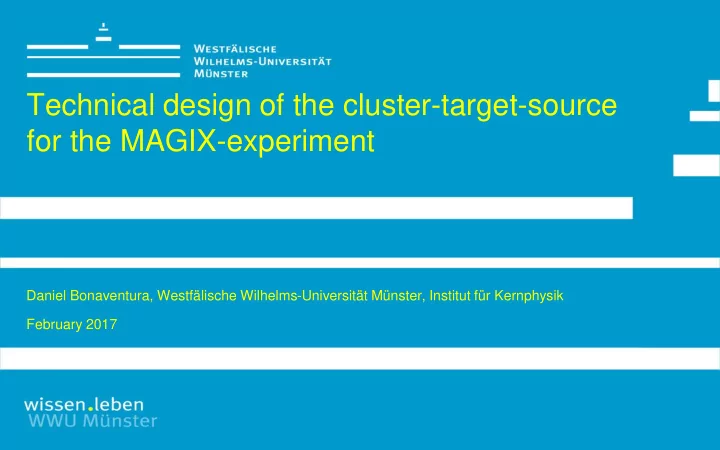

1 Technical design of the cluster-target-source for the MAGIX-experiment Daniel Bonaventura, Westfälische Wilhelms-Universität Münster, Institut für Kernphysik February 2017
2 Content • Target overview • Design of the gas cooling system (LN 2 pre-cooling) • Design of the gas cooling system (two stage cold head cooling) • Insulation vacuum and sealing • Nozzle assembly and sealing • Target assembly in Münster • Production of individually formed copper-nozzles
3 Target overview gas pre-cooling system (LN 2 dewar, 77 K) pre-cooled gas tubing Target boundary conditions: 1430 mm highly intense H 2 target beam needed (in the order of 10 19 atoms/cm²) Vacuum insulated interaction point close gas cooling, 21K to the target`s nozzle high detector acceptance H 2 gas nozzle 220 mm (0.5 mm dia.) around nozzle area accelerator electron beam target beam
4 Target overview gas pre-cooling system (LN 2 dewar, 77 K) Target requirements: pre-cooled gas tubing 1430 mm H 2 beam at 40 K and 40 l/min to reach required thickness Insulation vacuum for Vacuum insulated gas cooling, 21K gas cooling system interaction with electron beam H 2 gas nozzle close to the nozzle 220 mm (0.5 mm dia.) Insulation vacuum chamber with thin accelerator electron beam conical tip (20°) at nozzle feedthrough for maximum detector acceptance target beam
100 mm 5 Design of the gas cooling system LN 2 pre-cooling LN 2 storage dewar • 14 l filling volume (10 l usable) • LN 2 consumption app. 10 l/h Insulated H 2 -piping with vacuum feedthrough
100 mm 6 Design of the gas cooling system LN 2 pre-cooling Insulation vacuum Green: LN 2 volume Red: H 2 inlet (room temperature, 40 l/min) Blue: H 2 outlet (77 K) H 2 inlet Insulated coax tubing H 2 outlet
7 Design of the gas cooling system two stage cold head cooling • Two stage Leybold coolpower 10MD (coloured in blue) • Motor driven cold head • Gas inlet temperature 77 K, 40 l/min • Outlet temperature 1st stage app. 38 K • Outlet temperature 2nd stage app. 21 K
8 Design of the gas cooling system two stage cold head cooling 6 mm stainless steel tubing • Vacuum insulated feedthrough • H 2 gas transfer pipes • Several windings for temperature decoupling of 1st cooling stage
9 Design of the gas cooling system two stage cold head cooling 1st cooling stage (warm stage) • Copper cooling block including soldered gas pipes for optimum heat exchange • 2x 100 W heating power • 2x silicon temperature diode • Controlled by Lakeshore Mod. 336
10 Design of the gas cooling system two stage cold head cooling 6 mm stainless steel tubing • H 2 gas transfer pipes • Several windings for temperature decoupling 1st cooling stage from 2nd cooling stage
11 Design of the gas cooling system two stage cold head cooling 2nd cooling stage (cold stage) • Copper cooling block including soldered gas pipes for optimum heat exchange • 2x 50 W heating power • 2x silicon temperature diode • Controlled by Lakeshore Mod. 336
12 Insulation vacuum and sealing • Chamber made from stainless steel • Conflat flanges for all vacuum connections • Swagelok tube fittings for gas tubing • DN 100CF for turbo pump • Vacuum monitoring by Leybold ITR-200
13 Insulation vacuum and sealing Special formed polyimid sealing for nozzle feedthrough • High radiation resistance • Good sealing performance at minimum temperatures (max. 10 −5 mbar in IVC) • Reusable sealing
nozzle 14 (covered) Target assembly in Münster cold stage nozzle insulation vacuum chamber (covered by shielding) cold head warm stage pumping port gas inlet
15 Nozzle assembly and sealing 10 mm Nozzle mount assembled with nozzle extention • Nozzle mount sealing: Indium
16 Nozzle assembly and sealing Nozzle mount assembled with nozzle extention • Nozzle extention sealing: special Polyimid-sealing • Reusable • Leak tight at 20 K
17 Nozzle assembly and sealing 10 mm Nozzle mount with individually formed nozzle • Nozzle and mount welded
18 Production of individually formed cu-nozzles CAD-drawings of nozzle geometry • 45° inlet cone • 0.5 mm diameter at narrowest point • 7° outlet cone • 2 mm outlet diameter Nozzle negative • Turned from Aluminium
19 Production of individually formed cu-nozzles Electroformed copper positive • Formed in copper sulfate • Processing time 5 days • Outer geometry turned • Nozzle extracted mechanically
20 Production of individually formed cu-nozzles Turned nozzle mount merged with formed nozzle
21 Conclusion • New Target source set up with LN 2 pre-cooling and additional two stage cold head cooling • Target operation started for initial tests (vacuum, cooling, sealing) • Minimum H2 temperatures of e.g.< 40 K at maximum flow rates of 40 l/min • Using newly developed copper nozzles with individual geometries Outlook • Further development of copper nozzles • Developement of nozzles with different shapes (slit nozzles)
Recommend
More recommend